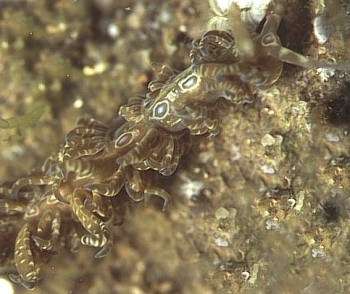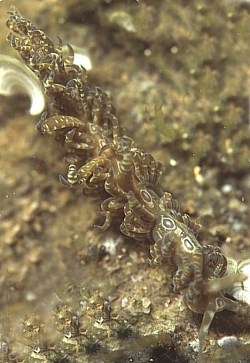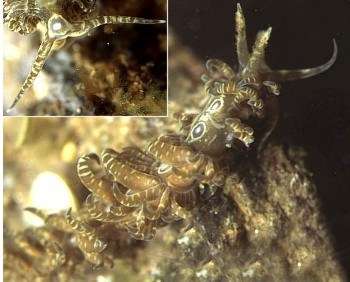Limenandra fusiformis from the Japan Sea
September 24, 1999
From: Shigeru Hayashi

Dear Bill,
Here is Limenandra fusiformis (Baba, 1949). The Japan Sea which lies between the Asian mainland and the west coast of Japan is partially enclosed and the warmer water fauna from the Pacific east coast is only rarely found in Toyama Bay, on the west coast of Japan.
I collected 2 individuals from 3m water depth in September 13, 1999, Toyama Bay, Kurosaki.
It spawns on the marine algae Sargassum. The body length is 60-70 mm.
We have records of it from: Kurosaki, Toyama Bay on August 27, 1994, Abugashima, Toyama Bay on August 28, 1994 and Huto, Noto Peninsula on August 30, 1998.
Sincerely yours
Shigeru Hayashi
Takaoka Biological Club
Toyama Pref. Japan
jr9dsx@tko.fitweb.or.jp


Dear Shigeru,
This is another interesting animal. There seem to be a number of aeolidiid species with a pattern of concentric rings on the body, especially on the head. As well as the the other species of Limenandra, another species that comes to mind is Spurilla australis.
Another interesting similarity is your mention that Limenandra fusiformis lays its eggs on Sargassum. Spurilla australis is also often found on brown algae, where it feeds on a small sea anemone which appears to live in association with the algae. Do you know what Limenandra fusiformis feeds on?
As with your photos of Elysia abei, it is very interesting to see these photos of a Japanese species for the first time.
Best wishes,
Bill Rudman.
Related messages
-
Re: Limenandra fusiformis? from the Philippines
From: Erwin Koehler, May 26, 2005 -
Limenandra fusiformis? from the Philippines
From: Erwin Koehler, May 25, 2005
